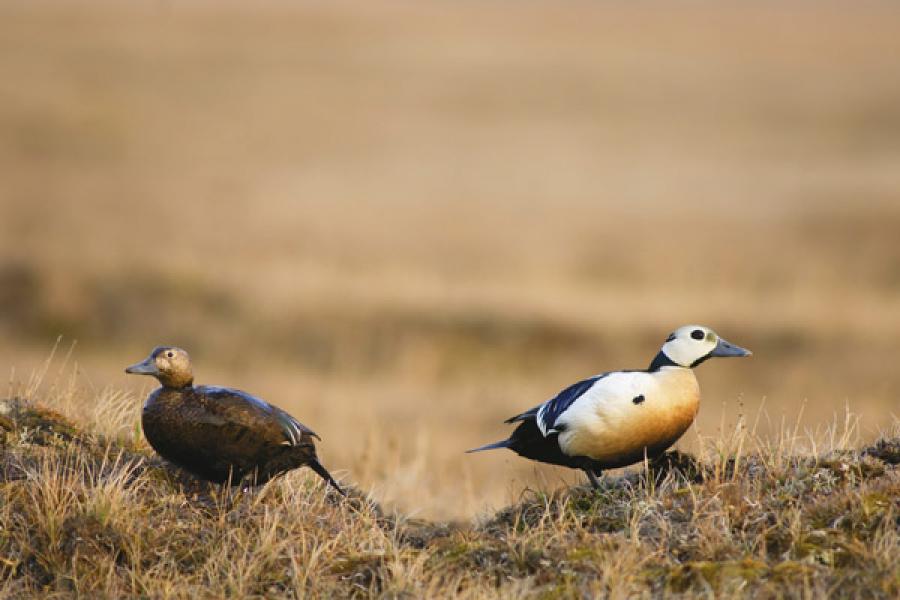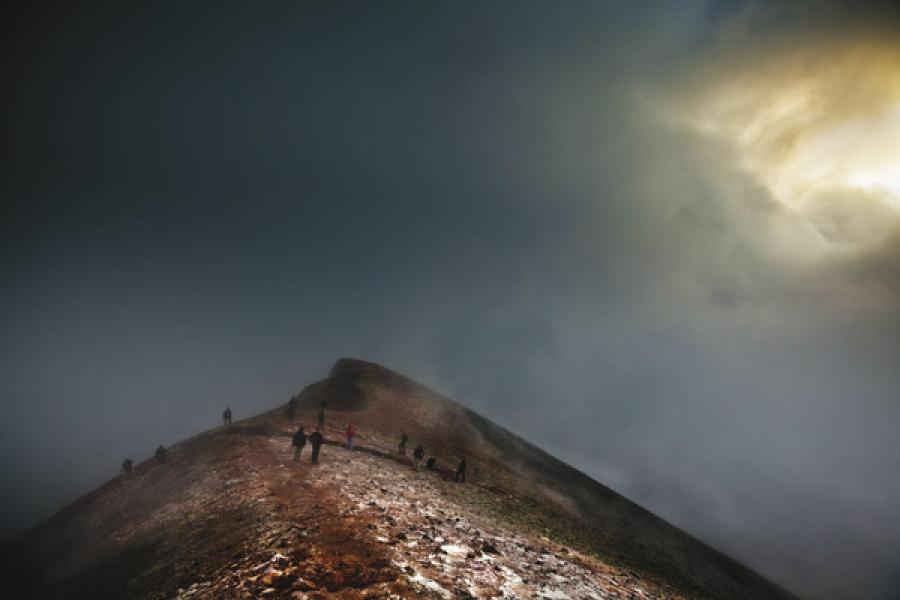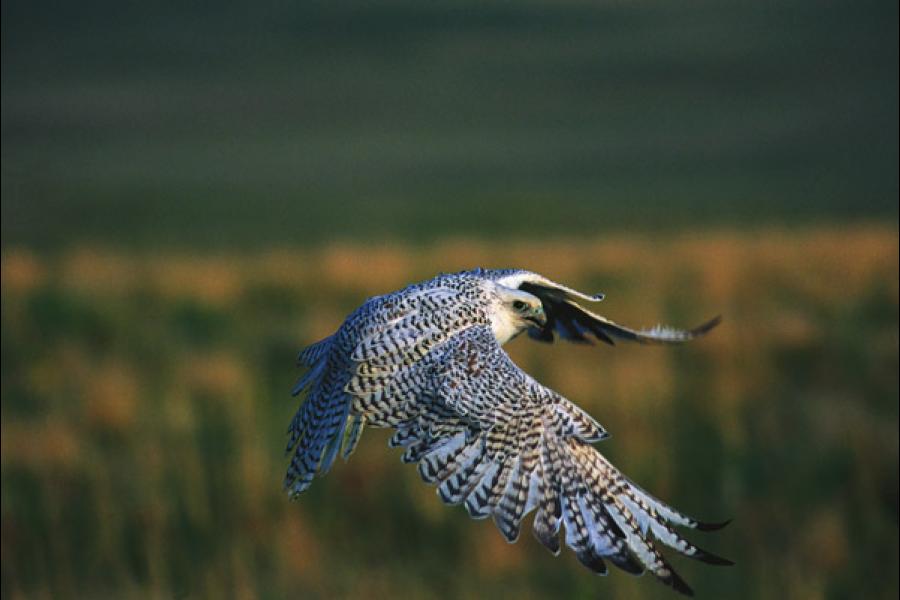
Iceland on the wing
This Nordic nation is a natural nesting spot for several kinds of birds. It is also home to volcanoes you can't pronounce
The T-shirt sums it up: Don’t F**k with Iceland – We may not have cash but we’ve got ash!
Cash refers to the fallout from an explosion: The effects of the global financial crisis on Iceland. Traditionally based on geothermal energy, fishing and agriculture, Iceland tried to reinvent its economy through financial services; one observer described it as “Wall Street on the tundra”. The results were disastrous, with the economy collapsing in 2008.
But we are not here to study that phenomenon. Our interest is Iceland’s geology and biodiversity, not its finances. But Iceland didn’t seem to want us. Several planned visits were disrupted by volcanic activity.
The most famous recent eruption—the cloud of volcanic ash disrupted global air travel for weeks—was that of Eyjafjallajökull in March and April 2010. A T-shirt provides assistance: Eyjafjallajökull is so easy to pronounce ‘Ay-uh-fyat-luh-YOE-kuutl-uh’.
In May 2011, Grímsvötn, a volcano located under the thick ice of one of Europe’s largest glaciers, Vatnajökul, erupted, spawning yet another T-shirt: Grímsvötn: So Much Easier to Pronounce than Eyjafjallajökull.
Fortunately, the ash cloud passed, allowing us to visit. My partner, Jade, and I had sworn that if we failed on this attempt, we weren’t trying again, ever!
Volcanoes dot the Icelandic landscape. It sits on a volcanic hot spot in the middle of the North Atlantic Ocean. The Mid-Atlantic ridge, which cuts through it, is literally pulling it apart, making it geologically young and active. It has lava fields, rugged hills, glaciers, glaciated valleys, fiords, glacial rivers and hundreds of volcanoes.
Volcanic eruptions are a regular part of Iceland’s history. In the 1960s, undersea volcanic activity off Southern Iceland created the island Surtsey, now a living laboratory where scientists study the development of new life forms.
Evidence of raw geo-thermal activity is everywhere. The earth is alive. The hissing sounds, the steaming vents, fumaroles and boiling mud pools are a constant reminder of Joseph Conrad’s observation: “[A civilised life is] a dangerous walk on a thin crust of barely cooled lava which at any moment might break and let the unwary sink into fiery depths.”
Even Iceland’s glacial ice is different. Near Eyjafjallajökull, what appears to be rock is actually glacial ice, blackened by massive amounts of volcanic ash.
The scenery is surreal, indescribably alien. It is easy to see why Jules Verne had his travellers set off on their journey to the centre of the earth from Iceland’s Snæfellsnes.
Iceland’s volcanism is a major attraction. Even eruptions bring tourists to the island, keen to get close views of the volcanic activity. When Eyjafjallajökull erupted and before the ash cloud prevented aircraft movement, tourists rushed to Iceland to get up close and personal with the volcano.
The hardy trekked for 12 hours up the mountain through snow and ice to get a better view of the exploding volcano. The less hardy took helicopters up to a suitable vantage point. At night, tourists gathered to watch the spectacular natural sound and light show as lava flows glowed eerily and ash and magma illuminated the sky.
Volcano tourism has its risks. Lava bombs the size of large rocks fell from the sky onto the snow very near where one group was standing. Our guide, Trausti, who told us of this, concluded with classic Icelandic understatement, “Maybe they were a little close.”
The landscape’s beauty is severe but overwhelming. While there are higher or more famous waterfalls, those in Iceland are more primal, untamed. At Gullfoss, a massive volume of water flows at speed down a three-step staircase and then abruptly plunges into a crevice over 30 metres deep, giving the appearance that the river has disappeared into the earth. As you approach, a thunderous roar that drowns out all human sounds proclaims the invisible waterfall’s presence. Both Jade and I stand quietly for minutes on end, the noise creating its own meditative state.
There are no life-threatening volcanic eruptions during our stay, so we console ourselves with the bird life.
The oceans of Iceland are highly productive, attracting birds. The abundant supply of fresh water and its location, an isolated landmass in the North Atlantic, makes it a natural nesting location or stopover on migrations.
Lake Mývatn—in Icelandic mý (midge) and vatn (lake)—and the surrounding wetlands are exceptional for waterbirds, especially ducks. Algae, water plants and aquatic insects provide an attractive food supply for many species of ducks, each distinctive in appearance. Take the adult male Harlequin Duck: Slate blue with chestnut sides and white markings including a white crescent at the base of the bill and a white ear-patch. You can see why it’s named for a colourful musical theatre character.
The coastal areas are home to large populations of seabirds. At Látrabjarg, the western-most part of Europe, we walk along Europe’s largest bird cliff, some 14 kilometres long and up to 440 metres high. The cliffs are home to millions of birds, including puffins, northern gannets, guillemots and razorbills. In some cases, the birds constitute a large proportion of the global population of the species.
Along the shoreline, you can see various wading and shore birds. Huge flocks of Red Knots, a species of sandpiper, rest and feed on their migration to their summer grounds. On the pebbly beaches, Jade’s favourite Ruddy Turnstones, a small wading bird with a distinctive harlequin-like pattern of black and white, live up to their name, carefully flipping over pebbles to get at prey items underneath.
The coast and nearby lagoons are the breeding sites of beautiful Great Northern and Red-throated Divers (known as Loons in North America). Great Northern Divers are resplendent with striking black heads, white underparts, and a chequered black-and-white mantle. Red-throated Divers are even more spectacular with dark grey head and neck, narrow black and white stripes on the back of the neck and a striking triangular red throat patch.
We choose to spend time in wilder, more remote areas: The Snæfellsnes peninsula, the western fiords and the north around Lake Mývatn and Krafla volcano.
Eschewing tour groups, Jade and I travel in a four-wheel Suzuki driven by our guide, Trausti (pronounced “Tristi”) Gunnarsson. Trausti is a classical scholar fluent in ancient languages, which is useful as geological terms and the biological names of birds are frequently in Latin. Trausti is also translating Pliny the Elder’s letters on the eruption of Mount Vesuvius for a book on volcanoes.
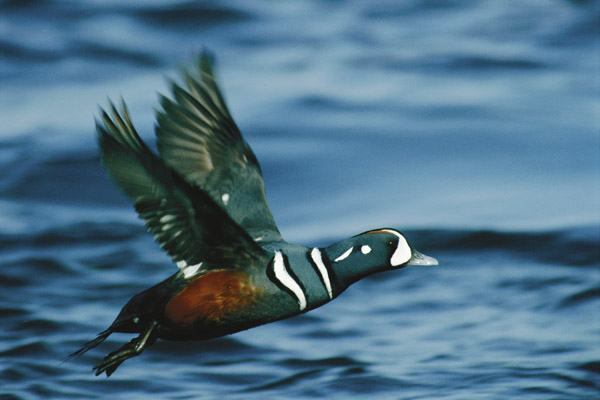
A slate blue Harlequin duck with chestnut sides and white markings
Iceland offers us many “lifers”, birder-speak for a variety seen for the first time. The coastal waters have Common Eiders, a large sea duck, whose insulating down is famous. Iceland yields us a very special lifer: A King Eider with its impossible multi-coloured head, featuring a coral red bill, a prominent orange knob at the base of the bill and a nape of blue with a hint of purple. Trausti finds it amongst a flock of Common Eiders. The rare sighting causes an Icelandic birding celebration: A yelp and a hop.
Later in the trip, Trausti achieves his own lifer, a Steller’s Eider. Named after the German naturalist Georg Steller, the bird’s breeding plumage is astonishing; grey bill, a lighter grey eye surround and a spectacular green loral patch on the back of the neck. Normally found in Northern Scandinavia, it is a vagrant.
Bird watchers—“twitchers”—have a deserved reputation for being anorak-wearing, socially challenged misfits. But they share a sense of community. In Iceland, the sighting of the King Eider and Steller’s Eider is communicated by text messages via the local birding association to allow other enthusiasts to share the experience.
Icelandic bird watchers also have quirky senses of humour. A Canadian couple, we encounter in our travels, excitedly recounts the sighting of a Mute Swan, very close to where we saw the King Eider. The Mute Swan is a majestic waterfowl with a very long neck with an orange red bill and a black knob on its forehead, normally only found in the UK and continental Europe. The Canadians animatedly speculate about how the bird found its way to Iceland. Trausti gently breaks the bad news to them: Their Mute Swan is a very accurate, lifesize blow-up rubber toy that an Icelander leaves in that pool each year to amuse himself at the expense of tourists. We smile knowingly, not letting on that we too were taken in.
Iceland is a good place for our favourite birds of prey, especially the world’s largest falcon, the Gyrfalcon. Long used in falconry and hunting, their rarity makes them expensive, the preserve historically of kings and nobleman and, today, Arab sheiks. Polymorphic, their plumage varies greatly.
Silver-white Gyrfalcons are especially prized and sought after. The trade in these birds has greatly reduced wild populations, threatening their survival.
At Lake Mývatn, we see a brown juvenile in flight and a pair at a distance. But near Krafla, we get lucky. Trausti parks by the side of the road to scan a nearby cliff face with his powerful scope. Gyrfalcons nest on cliff faces, often on a bare cliff ledge or the abandoned nest of other birds. Our patient scanning yields results. We spot a male, a rare especially pale morph. About 10 metres away on a lower ledge, we spot the female sitting on her eggs. It is a rare and fortunate sight in excellent light.
On the north side of Breiðafjörður, a large shallow bay about 50 km wide, whilst we are driving to our guesthouse at Brjánslækur, a raptor flashes past. We spot the Merlin, a smaller species of falcon, sitting on a roadside sign, providing a splendid close view of an adult male. The orange hue of its breast, blue grey wings, hooked dark beak and yellow talons are clearly visible. We watch for several minutes. Then the falcon suddenly takes off and disappears from view. About 100 metres on, we see it on the ground. The Merlin has killed a ring-necked plover, a small shorebird, taking its prey by surprise. The Merlin rapidly rips out the feathers and then feeds on the carcass. We watch for an hour as it eats. Finished, it carefully cleans its talons and beak, with vigorous rubbing on the grass. Then it flies off. Trausti clambers down the slope to collect a plover feather as a memento.
Later, we see another Merlin flying fast and low to take a small Meadow Pipit by surprise. The prey weaves trying to escape but the Merlin, a redoubtable aerial predator, wears the Pipit down.
At Gullfoss, Trausti finds a mating pair of Merlins. The nest is on a well vegetated nearby rocky ledge by the river. Trausti monitors the Gyrfalcon and Merlin chicks on trips to Krafla and Gullfoss through the season. Back home, we are thrilled to learn that the Gyrfalcon and Merlin chicks have all survived and fledged.
At Krafla, Trausti drives us into the mountains along an unsealed slippery road, navigating using GPS coordinates. He sought permission from the Geothermal Power Company to drive through private property. In an Icelandic way, the company official advised that he could neither allow nor disallow our trespass.
When the road ended, we got out and began walking. After about a kilometre, Trausti stopped and pointed to a ridge line which glinted in the sunlight. Obsidian Ridge or Hrafntinnuhryggur is a rhyolitic dyke at Krafla volcano which formed during the last glacial period. It was one of the first documented examples of a fissure eruption beneath thin ice. The ground is covered in large and small pieces of smooth, sharp obsidian, volcanic glass formed as an extrusive igneous rock. Hard and brittle, Obsidian can be cut with very sharp edges, allowing its use as a cutting or piercing tools.
Trausti had noticed my interest in a beautiful piece of polished obsidian in a museum. He knew about Hrafntinnuhryggur, although he had never been there. In an act of generosity and friendship, he wanted us to see this place. A few small shards of that precious obsidian now sit on a shelf at our home. It is impossible to capture the desolate majesty of Iceland and its savage landscape. The obsidian and our memories are reminders of an extraordinary place and the friends we made there.
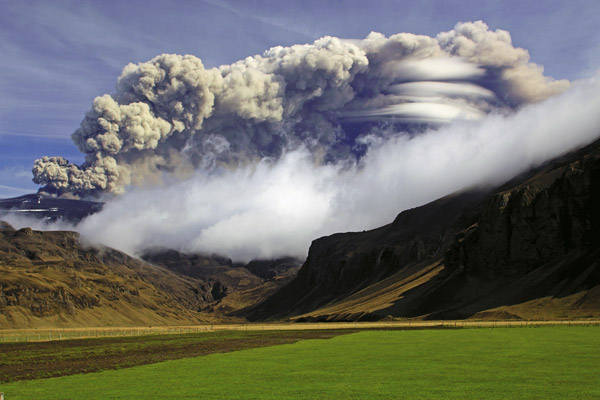
A rare volcanic lenticular cloud forms in the eruption cloud of Eyjafjallajokull
Icelandic Sagas
Iceland is not an easy destination. It is expensive. The weather is variable, windy and sometimes bitterly cold even in summer. The food is an acquired taste. Hákarl, fermented Greenland or basking shark, is a local delicacy. Lacking a urinary system, the primitive shark excretes waste through the skin. The flesh is poisonous when fresh, due to its high urea content. The shark is gutted, beheaded and then placed in a shallow hole dug in gravelly sand, where pressure removes fluids from the cleaned carcass. Then, it is cut into strips and hung to dry for several months. Hákarl’s ammonia-rich smell and fishy taste is similar to very strong blue cheese.
Celebrity chef Anthony Bourdain described hákarl as “the single worst, most disgusting and terrible tasting thing” he had ever eaten. Chef Gordon Ramsay challenged journalist James May to sample hákarl. When Ramsay vomited after eating it, May, who kept his portion down, commented: “You disappoint me, Ramsay.” For others with “disappointing” stomachs, a steady diet of porridge, cod and lamb is available.
But Iceland’s natural history makes it worth the journey. There are few places in the world where a traveller can experience the earth’s raw power and formative forces as directly.
Part of the attraction is a profound isolation. Iceland’s surface area is around 103,000 sq km and population is 330,000, making it one of the least densely populated parts of the world. Even in peak season, outside the main tourist areas near Reykjavík, we rarely encounter other visitors. Most people travel to Iceland in summer, around May to July, when the weather is better and there is near-24-hour sunlight. Snow sports lovers and travellers wanting to see the Northern Lights (Aurora Borealis) visit in winter. Almost all travellers arrive by air, usually Icelandair, which offers flights from and to many European gateways. Flight costs vary a lot depending on the season. The traditional tourist trail takes in Reykjavík, whose smart shops, trendy designers, restaurants and nightlife are a legacy of the boom years. The capital features lively music and interesting art. Iceland’s two best-known exports—after cod and lamb—are the eccentric singer Björk and post-rock band Sigur Rós.Tourists travel to Þingvellir in the rift valley of Iceland, home to the old Viking parliament. They have a dip in the Blue Lagoon (“Bláa lónið”) to bathe in the silica and sulphur rich waters, which is reputedly curative, although they are from a nearby geothermal power plant. And they visit Geysir, where the famous Strokkur used to erupt regularly.
This is Iceland tourism’s “golden triangle”.
You can hire a car and circumnavigate the island on a sealed road. Driving conditions vary. Most natural history areas are more difficult. Public transport between major cities is available but less so to more remote places.
A variety of hotels, guesthouses and bed-and-breakfasts exist.
A budget of US$300-1,000 per person per day is reasonable for accommodation, food etc. Our trip was arranged by Iceland Naturalist (Gudrun Andresdottir) who specialises in natural history travel in Iceland (+354 483 4178 / icelandnaturalist.com )
(This story appears in the 14 September, 2012 issue of Forbes India. To visit our Archives, click here.)

